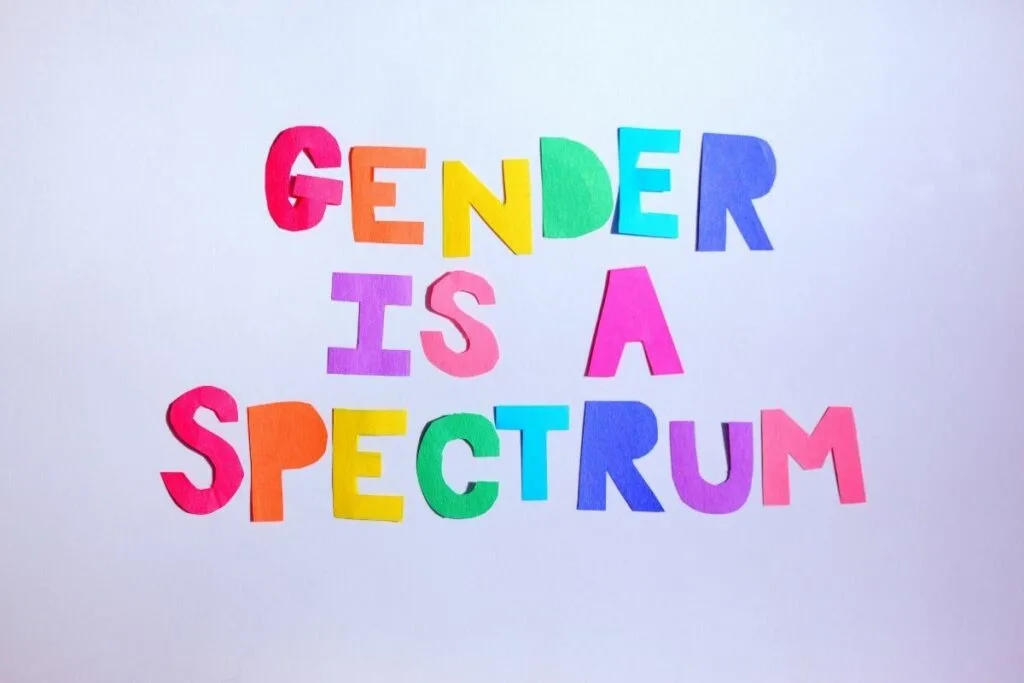We’re having more important conversations about gender today than we’ve had in recent years. These discussions aren’t limited to our families but are present in our communities, learning institutions, and even the media. Having these discussions means we can offer the necessary support to individuals and groups within the LGBTQ community.
One of the discussions about gender identity that seems to confuse people is whether there’s a difference between genderfluid vs. non-binary. People tend to assume that being genderfluid means one is closely associated with one gender rather than the one they were assigned at birth.
However, there’s a difference, just as there is between genderfluid vs. genderqueer and agender vs. genderfluid, which we have compared before. Let’s get into it.

Non-Binary is an umbrella term referring to people whose gender identity is neither female nor male. Non-binary includes those who believe they are bigender (a mix of male and female) and agender (they don’t identify with any identity or gender). Some individuals identify as part male or female and part agender (demi gender). Demigender sometimes are referred to as demi girls or demi boys.
Several other identities also exist within the non-binary.
Genderfluid is a part of the non-binary identity. Individuals that identify as gender-fluid recognize that their expression and their gender identity alters between female and male. When someone wears clothes that are normally associated with a gender that’s different from their presumed gender, they are, most of the time, presumed to be genderfluid.
However, these people may just have a habit of wearing feminine or masculine clothing, and they could be cisgender. The person may also be a trans woman and man in transition or identify as a man or woman while experimenting with gender expression.
You cannot judge a book by its cover and the only way to know whether someone is truly genderfluid is for them to tell you. If they tell you that their gender alters between male and fluid, their gender identity is genderfluid.


What Does It Mean To Be Genderfluid?
As we discussed earlier, people may use the term ‘genderfluid’ to describe their gender identity. The term falls under the non-binary blanket. When one is genderfluid, their gender identity may alter or fluctuate over time. Keep in mind that being genderfluid may mean different things to different people.
Genderfluid people can express being androgynous, feminine, or masculine in their self-concept, personality, and sexual experiences. At times, genderfluidity may be a way for some youth to explore gender before they settle on one identity or expression.
For other people, genderfluidity is the only experience they have with gender.
Keep in mind that not all people who experience fluctuations in their gender expression may identify as genderfluid. In addition, not all people require gender-affirming treatments to change their bodies to fit their gender identity. It’s also important that people don’t confuse the term genderfluidity with sexual fluidity. These two terms are different.
Sexual fluidity is the ability to be flexible about the person you’re attracted to, while genderfluidity is being flexible about your gender identity.

What It Means To Be Non-Binary
Non-binary people are all thought to fall under the transgender umbrella. However, some don’t identify with being transgender.
Historically, the term was used to define the movement from one binary gender to another, but today non-binary is typically used as a broad term for gender identities that are neither male nor female—identities that exist outside the male/female ‘gender binary’.
Types of Non-Binary Gender
By now, you already know that non-binary is a gender identity and an umbrella term used to describe gender identities other than man or woman. Here are some of the most commonly discussed types of non-binary gender:
- agender: The gender identity of agender individuals is undefined and neutral. They don’t have a specific gender identity. They are sometimes referred to as neutrois or genderless.
- Bigender: Being bigender means that individuals have two different gender identities that they may identify with either alternatively or simultaneously.
- Genderfluid: An individual fluctuates between two or more gender identities.
- Genderqueer: A term used to refer to all individuals with non-binary gender identities. This term may be the main identity of some individuals. However, it includes a slur. Unless an individual expressly identifies with it, please do not use it on them.
- Non-Binary: This is an umbrella term for all gender identities existing apart from the gender binary.
- Two-Spirit: This is a pan-tribal term that the indigenous Americans created to refer to several genders that are specific to ceremonial/social roles. Many indigenous tribes have distinct gender identities that aren’t within the binary. However, Two-Spirit is a term for all indigenous Americans, sometimes referring to a specific identity.
- Demigender: People who identify partially or predominantly one gender yet at the same time are still attached in part to another gender. There are several subcategories of the demi identity, including a demi-boy or demi-man, which signifies at least partially with being a boy or a man (no matter the sex and gender they were assigned at birth) and partly with other genders or with no other gender (agender). A demiflux person considers that the stable part of their gender identity is non-binary.
- Pangender: A person who hasmultiple gender identities. Also known as polygender or omnigender some pangender peeople may identify as all genders at the same time.
- Transfeminine: Any individual, binary or non-binary, who was assigned male at birth and has a predominantly feminine gender identity or presentation; transmasculine is the equivalent term for someone who was assigned female at birth and has a predominantly masculine gender identity or presentation
Now that we know the genderfluid is a gender identity within non-binary, here are some things people may assume about the non-binary community or individuals.

What You Should Know About Non-Binary Individuals
- One Cannot ‘Look Non-Binary‘
It’s not possible to tell someone’s gender identity just from looking at them. Most people know that just because you are a cis man or woman doesn’t necessarily mean that you’ve got to wear pants or dresses, respectively. In addition, some believe you can only wear androgynous clothes if you’re non-binary.
It’s always important to ask about someone’s gender identity rather than assuming because of how they look.
Even if someone looks feminine, is in heels, and has long hair, it doesn’t mean that you should automatically use she/her pronouns on them. Doing this means you’re gendering someone’s presentation, which is wrong. Just because someone presents differently from your expectation doesn’t mean they aren’t non-binary. There’s no one look that says one is non-binary – and always asking and then using someone’s pronouns beforehand is the best way to ensure everyone feels comfortable.
- You Can Have More Than One Gender Identity
It’s possible to identify as non-binary and trans, a woman, a man, or even something else. When one identifies as a non-binary man, it means that their gender identity acknowledges they don’t have an inherent identification to any gender and that they may have been socialized as a man. However, always keep in mind that having multiple gender identities may mean different things for different people.
For instance, while one may identify as non-binary and a man, it may mean that they love their male body but know that it doesn’t represent them accurately.
- They/ Them Pronouns Aren’t For All Non-Binary People
Different non-binary individuals prefer various pronouns. For instance, there are those that go by he/him, or they/them, or she/her. The only way to know what pronouns someone prefers is to ask them. On the other hand, some don’t have a preference or have a specific one they’d like used and would be offended if their wishes aren’t honored. Not calling someone the right pronoun is like not calling them their right name. Be a good human and respect this.
- Not All Non-Binary People Are Transgender Or Intersex
Some people think being non-binary is being intersex. This means they have a body that traditionally isn’t referred to as female and male. Non-intersex and intersex people can both refer to themselves as non-binary. Other people think that being non-binary means you’re transgender. And, while there are non-binary individuals who identify with this, there are also those that don’t.
- Being Non-Binary Is Not A Fad Or Trend
More and more, people are getting used to seeing transgender individuals living and experiencing their gender identity. This is because it’s easier to explain the feeling of being more in harmony with the opposite gender.
However, it’s harder to explain when one’s gender identity is outside or in the middle of the gender spectrum. Being non-binary is a real identity that has been in existence for thousands of years and is not a phase or a personality trait.

- We Didn’t End Up With The Wrong Body
While some feel this is true for them, it’s not the right notion for all non-binary people. Not all non-binary people feel like they were ‘born in the wrong body’. Mostly, non-binary people would feel that they were assigned the wrong gender because of other people’s misconceptions about their bodies.
Body dysphoria can happen because of external influences by society or other LGBTQ spaces that insist people should look a certain way. As a result, non-binary people may end up feeling unsettled, broken, or even feel confused.
In addition, non-binary individuals don’t always have the notion that this is how they were born. For some, their dissatisfaction with being assigned as a woman or man comes later in life. For others, there’s an inherent realization that their gender is different from the binary and that it may be more complex than what they’ve been socialized into.
- There’s No Requirement To Be Equally Feminine Or Masculine
A non-binary person isn’t necessarily equal parts woman and man. Non-binary individuals have the liberty to identify as masculine or feminine to different degrees, and this may also fluctuate at different times. Also, some don’t identify with the concept of femininity or masculinity at all.
One cannot determine how feminine or masculine another person is. These are just labels applied to specific traits. What may feel masculine or feminine in different cultures may differ from what other cultures define as feminine or masculine. The truth is that such variations don’t mean that any of them are wrong – or any of them right. Gender and gendered traits are social constructs that change over time and are interpreted differently in various spaces or cultures.
- You Shouldn’t Have To Prove Your Gender Identity
Maybe you identify with this if you’re non-binary. People may think that you’re a man or a woman just because you don’t do anything differently as people who identify with these genders. Even though you act or dress the same as people in the binary or don’t talk about being non-binary, that doesn’t mean you aren’t.
You don’t have to prove to anyone that there’s something special about you, come out when you aren’t ready, or try to act differently than you did in the past. Gender is a personal concept, so you are who you say you are. Just because you’re different from other people doesn’t mean there’s something wrong with you.
Many people assume that being non-binary is a complicated thing. Non-binary may be weird for those who aren’t used to thinking outside the box that society and the patriarchy have tried to force us into—however, those of us who understand what it means are better off for it. When you’re non-binary, you create meaning for the term in your own words.
- Learning What You Can About Being Non Binary Isn’t Trying to Fit In
Learning about the assumptions we’ve talked about above is a great thing. First, you uncondition your mind from all the assumptions you’ve been making. Secondly, it’s a great idea to educate yourself about non-binary gender identities so you can offer support or understand the people in our lives (family, friends, colleagues, and others) who identify as non-binary.
Trying to understand experiences that non-binary people go through can be overwhelming or difficult for people who identify with the gender they were assigned at birth. However, being human means that we learn to accept that people are different and that we all have distinct experiences in life.
It also means that we offer more support to other people in our lives that are trying hard to be as comfortable as they can with who they are. This is definitely something that all of society can aspire to do.
Just a Recap Of Genderfluid Vs. Non-Binary
When someone identifies as non-binary, it means they don’t identify with the two sides of the gender spectrum- man or woman. Non-binary individuals are in the middle of the gender spectrum, or not on it at all. Non-binary is both an umbrella term and a gender identity.
When you’re genderfluid, it means that you fluctuate through different genders at different times. It could be days, weeks, or even months. At one time, you may feel like a man and describe yourself with the appropriate pronouns, and at a different time, you may feel like you don’t belong to any gender at all.


